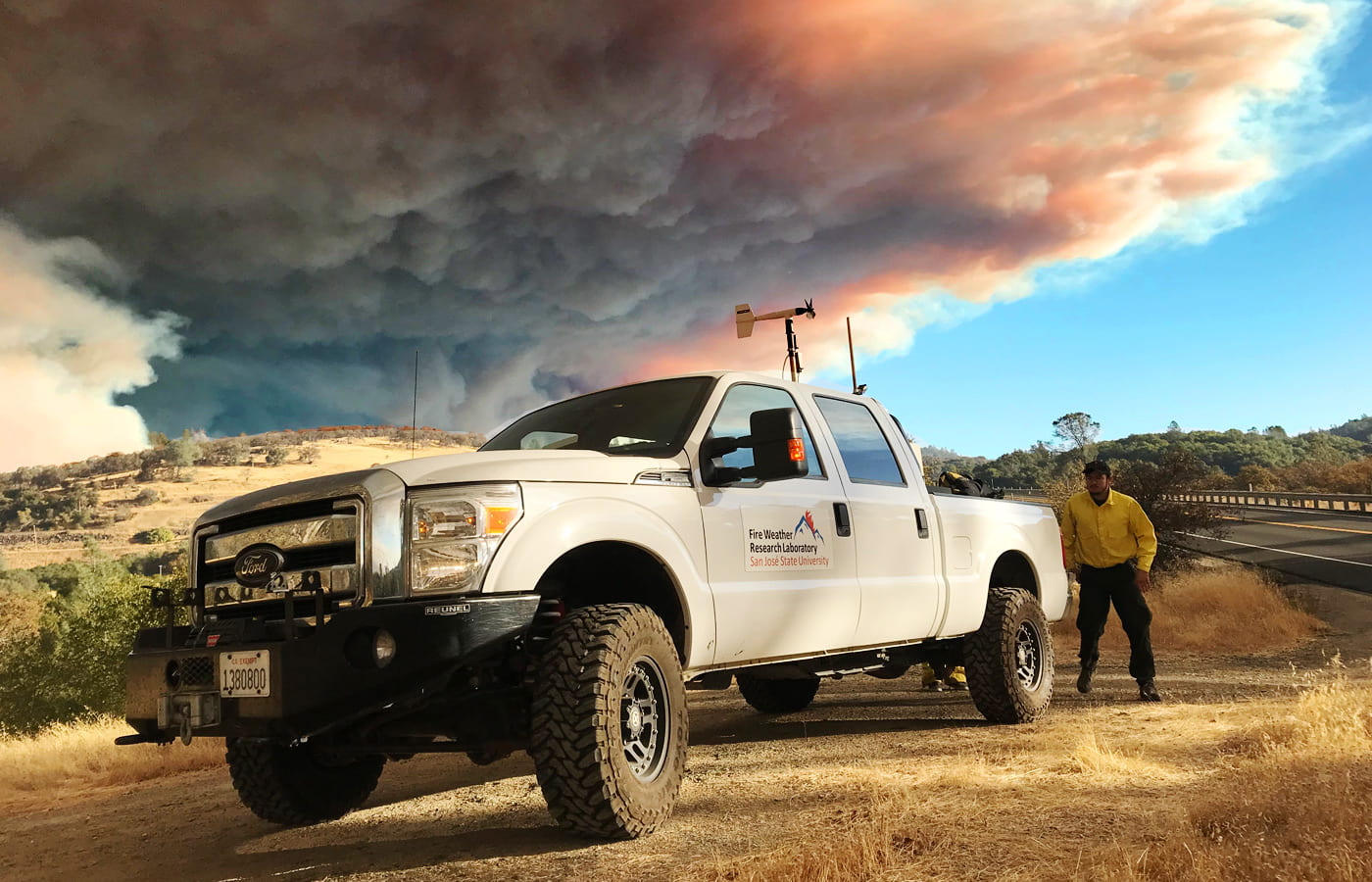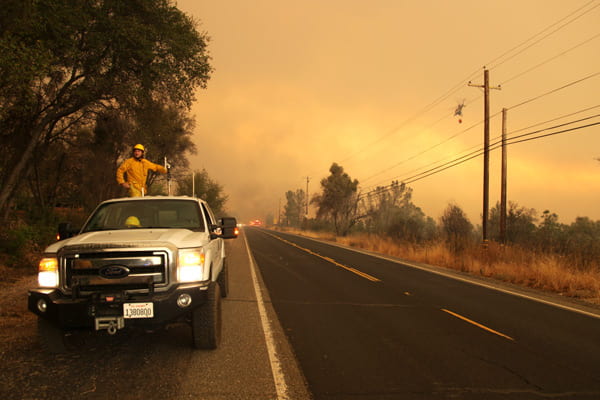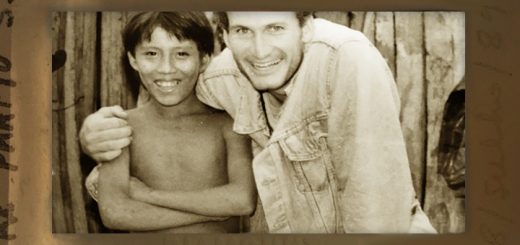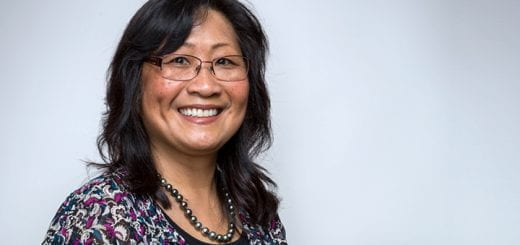On Fire
The only team of its kind in the United States, Craig Clements’ Fire Weather Research Laboratory studies and decodes wildfire behavior to improve fire management and prevention.
In November 2018, a catastrophic wildfire ravaged the mountainous town of Paradise, killing 85 people and destroying entire neighborhoods. While firefighters, first responders and local officials worked to evacuate survivors and salvage the remains, a group of SJSU scientists gathered data using meteorological instruments on the back of a research truck one hundred feet from the flames of the deadliest wildfire in California’s history.
Spearheaded by Associate Professor of Meteorology and Climate Science Craig Clements, the Fire Weather Research Laboratory is the only team of its kind in the United States. With the only program in the nation that trains wildfire meteorologists, Clements is driven by a desire to understand how fires create their own weather and to what extent their behavior can be predicted.
“Wildfire meteorology is a relatively new field,” Clements says. “Now that these fires are causing more damage, we need a better fundamental understanding of fire behavior, particularly in mountainous terrains. We don’t know how winds around wildfires work. With better observations, we can better predict fire spread in the changing climate.”
Clements estimates that he has collected data on at least 24 wildfires since his lab was established. To collect the most useful data, he needs to be as close to the smoke plumes and the height of the fire as possible without getting in the way of first responders or putting anyone at risk.
Preparing the Team
Not just anyone can approach an active fire, much less set up a data collection station. When Clements recruited former firefighter Carrie Bowers, ’18 MS Meteorology, to his team in 2014, they collaborated with her contacts in the U.S. Forest Service to pursue fireline qualifications for their research team. By enrolling in fire science classes and completing specialized training with professionals from Tahoe National Forest, Clements and his team earned the certification necessary to become technical specialists at fire incidents.
Though the lab’s primary objective is to collect research data about fire behavior, Clements is dedicated to supporting the U.S. Forest Service, the California Department of Forestry and Fire Protection (Cal Fire) and other first responders, especially at incidents where the data they collect could make an immediate impact.
“It’s a win-win situation,” says Bowers, who now works as a fire science meteorologist for San Diego Gas and Electric. “We were able to get connected with the incident management team for the fires and get included in the resources that are assigned to that fire. They would give us fire behavior information and we could give them weather information.”
During a fire incident, they use LiDAR, a tool that detects material such as smoke or ash by beaming light into the atmosphere. By attaching LiDAR to bed of the research truck, Clements and his team have adapted a unique technique for observing the dynamics of the smoke plume while the LiDAR scans, collecting information on plume height, location of atmospheric materials and wind speed. As of early 2019, Clements had obtained additional grant funding to purchase radar.
The added tools will collect data that helps decode fire behavior, hopefully informing fire management and prevention. This is especially important, Clements says, because California residents should expect more fires in the seasons to come. For more than a century, fire management agencies have managed fire by suppressing it—extinguishing it, without allowing any excess fuel (brush, dead or drought-damaged vegetation) to burn.
He explains that it is natural, and even healthy, for fires to occur periodically, and they only become newsworthy when they destroy cities or communities like Paradise, Redding or Malibu. Over the last few years, it has become common for fires, carried by changing temperatures and sudden shifts in wind direction and speed, to overtake urban areas that were unprepared to respond. The 2017 Tubbs Fire, which destroyed more than 5,000 structures and incurred more than $1 billion in damage, was unique because once the fire approached Santa Rosa, the houses, buildings and city itself became fuel to ignite the fire further. This phenomenon has catastrophic repercussions and represents a shift in the way firefighters, and scientists must learn from and respond to natural disasters.
“Land management agencies have been putting out wildfires when they should have let them burn naturally,” explains Clements. “That’s why we have fuel accumulation. And because climate change causes the fuels to dry out, the problem is more complex.”
Fire Modeling
During that feverish weekend in Paradise, Clements was joined by undergraduate researcher Jackson Paladin Yip, ’19 Meteorology, and graduate researcher Matthew Brewer, ’20 MS Meteorology, who collected wildfire data and communicated with the incident command center, relaying weather information and moving when the situation demanded. As they witnessed survivors fleeing, saw neighborhoods burn, and watched firefighters and first responders make sense of the limited paths out of Paradise, Clements’ team was monitoring the LiDAR amidst the climbing flames. The heartbreaking experience of watching the landscape burn reinforced the scientists’ resolve to understand the science behind fire.
“We’re doing groundbreaking research on a lot of phenomena that no one has any idea about,” says Brewer, who is writing an analysis of the Paradise fire data for his master’s thesis. “Data we collect from our LiDAR can be used to validate computer models, which in turn will help improve fire models and gain a better understanding of the phenomena. While we’re not actively preventing fires, we are looking at fire-atmosphere interactions to help with fire models and better understand why things happen.”
Computer models of fire behavior can simulate the size, temperature, and velocity of fires, thus helping agencies rehabilitate ecosystems after a fire, says Diana Craig, ’82 Zoology, ’86 MA Biological Science. The deputy director of ecosystem management for the U.S. Forest Service’s Pacific Southwest region oversees a staff of hydrologists, soil scientists, tree specialists, botanists, wildlife biologists and natural resource specialists. Their work includes coordinating teams dispatched after fires in the Burned Area Emergency Response program.
By managing ecosystems and reducing fuels through mechanical treatments and controlled fires in prescribed burns, Craig says that they hope to reduce the risk of large, high-severity wildfires. “Fire behavior modeling feeds into fire suppression and fuels reduction,” she says. “It helps us determine what makes the most sense and where to start our work.”
Her staff collaborates with local forest teams across California’s 18 national forests, working with state agencies, fire safe councils and private landowners on “shared stewardship” strategies to reduce fire impact in spaces where private and public space overlap.
“Fire doesn’t see any boundaries,” says Craig. “It doesn’t care if there’s a fence. Working together, everyone tries to find ways to make the situation better for our lands, our forests, our ecosystems and our species.”
After the Smoke Clears
“To be able to go and do a field study on an active incident is very unique. The opportunities that it has allowed me have been amazing.”
–Carrie Bowers, ’18 MS Meteorology
In 2018, months before the Paradise tragedy and not long after the Carr Fire burned through Redding, the federal government cut the Joint Fire Science program, an interagency collaboration that supported hundreds of research projects focused on fire mitigation and prevention. Given that there are relatively few wildfire researchers like Clements, who are grant-supported and can hire undergraduate and graduate assistants, there is an even greater need to collect and analyze data that could support emergency responders, survivors and victims, as well as fellow scientists committed to predicting and managing natural disasters.
The Fire Weather Research Lab’s findings have a global impact—data that they analyze can be applied to regions that also struggle with fire suppression and fuel accumulation. After collecting data in Paradise, Clements, Yip and Brewer returned to San Jose to begin analyzing results. Clements had previously committed to speaking in Barcelona that same week, where he toured a region that faces similar drought and fire risks. He has also partnered with scientists in New Zealand and Australia to study wildfire behavior during their peak seasons. Despite bleak predictions of fires to come, the professor maintains that there are still some actions that citizens can take to reduce fire risk.
“We need prescribed fire back in the ecosystems,” he says, describing safe methods for monitoring small fires to eliminate fuel. “You can mitigate the risk by managing power lines, keeping people out of the wildland, and improving fire danger calculations. Don’t have a campfire if you don’t need one. Manage your house—keep pine needles off your roof and out of your gutters.”
Clements says it is critical to cut greenhouse gases, stop global warming and reduce our carbon imprint. To do that, it is necessary to consider alternative energy, electric cars, and adopting fire-safe practices at the community and statewide level. He warns that unless people are willing to make large and small lifestyle changes to keep the environment safe, “we are looking at a few hundred years of this weather pattern.”
Though there are still many unanswered questions, Yip sees their work as hopeful.
“In terms of research being generated, San Jose State has one of the best meteorology programs in the country,” he says. “Our industry is really working on how to improve conditions. Over time, fuels should improve, though fires will keep happening. I think there is hope in terms of the severity of fires as we get more insight into forest management in a more holistic way.”
Where will the Fire Weather Research Lab go in 2019? Wherever the weather dictates, wherever the plumes beckon, wherever there is room for two research trucks, LiDAR and radar pointed skyward, ready to gather data that could one day help make the world a safer place.







How can I get Carrie to speak at our Women in Safety Excellence event ? We are American Society of Safety Professionals of Greater San Jose. I am the inaugural chairman of WISE and I’m so enthralled to learn that this information is so close. If she cannot come to us at The builders group or the Biltmore, let us know where we can meet her. Mary Stine
Thanks for this excellent article on fire research…Great work by the team of professor and students. I was very impressed by the PBS documentary featuring SJSU professor and his team.
One suggestion: in the future, some type of SJSU branding should be displayed. Whenever Cal or Stanford have their staff interviewed, a school backdrop or trademark is displayed. SJSU is a wonderful university doing good and important work. It is often overshadowed by its cousins to the north. One way of getting recognized is displaying the university logo of prominent university feature like Tower Hall. Just some food for thought…